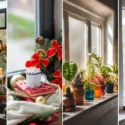What is a Window Jamb? Is it Necessary for a Window?
A window jamb is part of the structural support of a window. Jambs are located inside the framing of the window, along the top and sides, and in the case of windows that open, jambs can house tracks or rails used to manipulate the window, along with devices such as latches which are used to lock the window when it is closed.
Similar structural supports around a door are also known as “jambs,” and a “jamb” more generally is any type of vertical support around an opening.
Technically, window jambs are known as side jambs when they are along the sides of the window, and as head jambs when they run along the top of the window.
Jambs are not necessarily required, but they are common to many window installations. Numerous companies that produce windows also make matching jambs and jamb extensions which can be used to help their products fit more snugly; the jamb can be a weak point in a window if it is not installed properly, allowing for leaks or security concerns.
The material used to make a window jamb can vary and may be wood, plastic, vinyl, or metal. Window jambs may be painted to match the trim on a structure, or left unfinished, depending on the material and the aesthetics of the structure.
In cases where windows start to move unevenly or gaps appear around the window, replacing the window jamb can sometimes resolve the problem, with less cost than replacing an entire window or reframing the whole window.
A contractor can determine whether or not a window jamb needs to be replaced and do the work relatively quickly.
People who are handy with basic construction tasks can also do work on their own window jambs, ranging from fitting new ones to allow a new window to fit into an existing opening to replacing old jambs that are starting to warp, rot, or leak so that an original window can be left in place.
It is important to take time when working with window jambs, as a failure to fit them snugly and properly can result in problems ranging from a window that will not open to a window that is so loose that it is easy to pop out of the frame.
People inspecting structures they are thinking about purchasing should also take time to examine the window jambs. If windows are leaky, the jambs will betray signs in the form of staining and rot.
In addition to indicating that the jambs need to be replaced, rotting and staining around a window jamb could suggest that there may be other water damage that is not visible, such as rot as the result of water seeping into the structural framing.
The Purpose of the Window Jamb
Many window manufacturing companies also start making matching jambs and jamb alterations which can be used to assist their products to fit quite tightly; if it cannot be properly installed, the jamb could be a weak spot in a window, enabling leakages or security issues.
A window jamb is the frame of the window and can be made of wood, vinyl, or aluminum. A jamb is an integral part of a window because, without it, water would leak in.
Water would also leak in if there are no weather-stripping seals along the windowsill and around the sides of the frame. It’s always best to have good-quality weather stripping when installing new windows to ensure they last as long as possible.
Based on the conditions materials and the aesthetic appeal of the framework, window jambs may even be painted to fit the undercut on a structure, or left undone.
Common Problem With Window Jamb & How to Fix!
In situations in which windows begin to move unequally or disparities appear from around the window, the issue sometimes can be solved by removing the window jamb, at much less cost than replacing an entire window or reframing the entire window.
The worker can assess whether or not such a window jamb needs replacing and function properly pretty fast.
Individuals who’ve been helpful with fundamental construction works could also work on their own windshield jambs, varying from fitting new ones to allowing a new window to fit through an existing entrance to replace old jambs which are going to start to warp, decay or release so the actual window could be left in place.
It’s worth taking some time when going to work with window jambs because failure to fit them smoothly and properly can lead to complications varying from either a window that doesn’t open to a window that was so loose that it is indeed easy to knock out of the frame.
People surveying the frameworks they are thinking regarding buying really should start taking time to evaluate the window jams. If the windows are stinky, the jambs will forsake the indications of discoloration and rotting.
In addition to specifying that the jambs will have to be replaced, decomposing and smudging across the window jamb might recommend that there could be other standing water that is not visible, like rot as a result of water leaking into the structural frame.
Types of Window Jambs
The most common type of window jambs is interior-installed and exterior-installed. Interior-installed windows have their jambs installed inside the wall, whereas exterior-installed windows have their jambs installed outside the wall.
The third type of jamb that was mentioned earlier is called concealed, which means that you can’t see them at all.
Here are some common window Jamb:
1. Wood Window Jambs
Wood window jambs offer a classic and timeless appeal. They are known for their natural beauty and excellent insulation properties. However, they require regular maintenance to prevent rot and decay.
2. Vinyl Window Jambs
Vinyl window jambs are popular due to their low maintenance requirements and affordability. They are resistant to moisture and do not require painting. However, they may not match the aesthetic of traditional homes.
3. Aluminum Window Jambs
Aluminum window jambs are lightweight, durable, and ideal for modern designs. They are resistant to rust and provide excellent structural support. However, they are not as energy-efficient as other materials.
4. Composite Window Jambs
Composite window jambs combine the best properties of various materials. They are low-maintenance, durable, and offer good insulation. However, they may be more expensive than other options.
Do All Windows Need Jambs?
A window frame without jambs will not be complete. Window jambs are vertical pieces of wood or metal that form the outside edges of your windows.
They serve to provide support, and also help with insulation by preventing air from leaking in. While you can get by without them, they are an important part of your home improvement project and should not be ignored.
What are Jamb Extensions?
Originally indicating the vertical members of the frame, the term “jamb” has come to mean the frame in which a window or door sits.
Jamb depth varies between window manufacturers — vinyl windows typically are 2 5/8” to 3 3/8” thick while wood windows range from 3 1/2” to 4 9/16”.
In turn, jamb extensions refer to wood or another material that adds width to the jamb so that the window fills the entire opening depth from the exterior to interior sheathings (often plywood or oriented strand board on the outside and drywall on the inside).
In this way, casing or trim material simply needs to be added to the vertical wall surfaces after the windows are installed.
Without jamb extensions, a skilled trim carpenter or drywall installer is required to fill the unrequited space with wood, drywall, or another material before the window can be trimmed, so having jamb extensions applied by the window manufacturer can save labor expenses on the job site.
Window Jamb Installation Process
Installing window jambs requires precision and care. Here’s a step-by-step guide:
Measuring and Sizing
Accurate measurements are crucial to ensure the window jamb fits perfectly within the opening.
Preparing the Frame
Preparing the window frame involves cleaning, repairing any damages, and making sure it’s level and square.
Installing the Jamb
Carefully install the window jamb into the frame, ensuring it’s plumb and secure.
Sealing and Finishing Touches
Seal the gaps around the window jamb to prevent air and water infiltration. Add any desired finishing touches.
FAQs
Jambs are the main vertical components that form the sides of a window. A head or head jamb is the vertical component that sits at the very top of the window frame.
Window jambs are typically made of wood-like board materials, but they can also be made of metal. The material of the window jamb depends on what type of home it belongs to.
The framework includes three major elements: a sill or horizontal strips all along the bottom of the frame; the jamb, the vertical sides of a window; as well as the upper side strip on the frame. There are also several elements to the sash. The designs are the vertical parts of the sash. The rail is a horizontal segment.
The head jamb of a window is the vertical piece of wood or metal that holds the window in place. The head and sill are the two horizontal pieces that make up the exterior frame of any window. They form an L-shape with the sill below and the head above. Typically, you will have at least one set of double-hung windows in your home and each set will have two head jambs.



